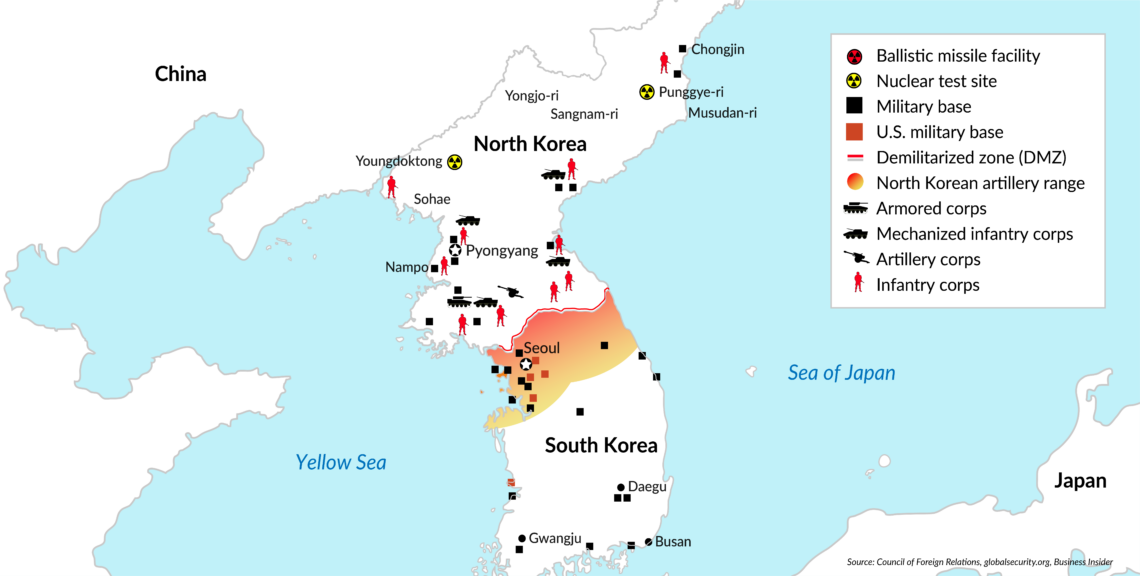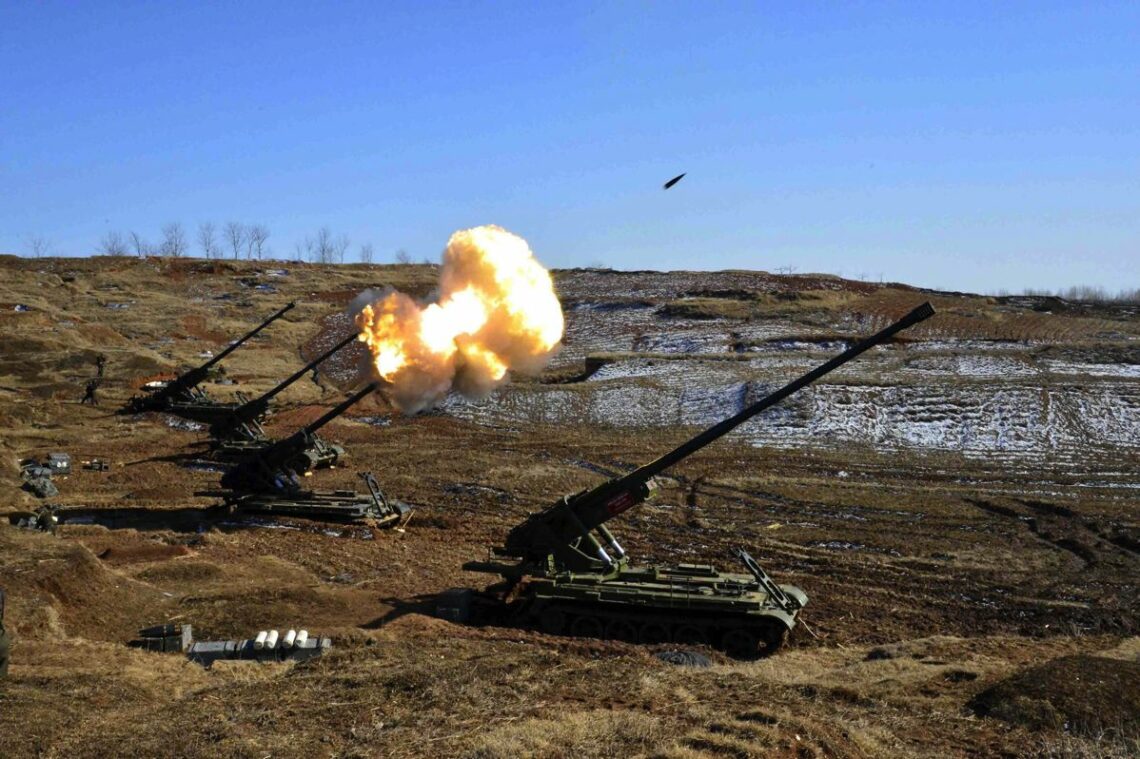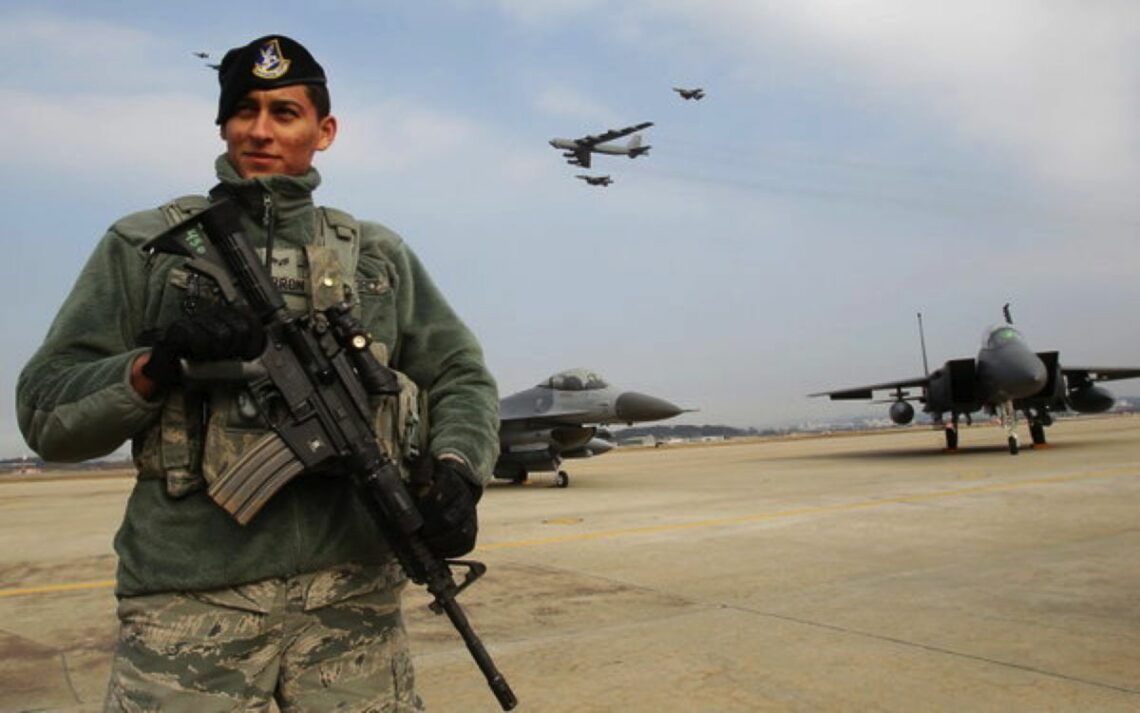The ‘neutralization option’ in North Korea
The possibility of the United States launching a preemptive attack against North Korea’s nuclear missile program appears to have receded with Pyongyang’s recent peace overtures, but the two are connected. The conventional wisdom holds that such a strike, dubbed a “bloody nose,” is unthinkable.

In a nutshell
- Despite peace overtures, the U.S. is convinced a nuclear North Korea is a dire threat
- Experts believe a limited, “bloody nose” military strike won’t deter Pyongyang
- But superior strength and intelligence give the U.S.-ROK militaries other options
The question of whether the United States would launch a preemptive attack against North Korea’s nuclear and intercontinental ballistic missile programs appears to be temporarily off the table after this month’s surprising peace overtures from the supreme leader in Pyongyang, Kim Jong-un.
In any case, the conventional wisdom holds that a limited, surgical U.S. strike on these targets – dubbed the “bloody nose” strategy – would be ineffective and unthinkable. But close examination of the history of U.S. war planning in Korea, together with the intelligence and military capabilities already in place, suggests that this view is mistaken.
There is no question that the present diplomatic opening, which began with North Korea’s acceptance of the first senior-level government talks with the Republic of Korea (ROK) since 2015, has created a sense of optimism. The U.S. and South Korea agreed to hold off their annual joint military exercises until the conclusion in mid-March of the Winter Olympics and Paralympics, held this year in the mountain resort of Pyeongchang. Mr. Kim agreed to send athletes south for the games, along with his sister, Kim Yo Jong.
Ms. Kim did more than captivate the media; she also bore an invitation to South Korean President Moon Jae-in for the first inter-Korean summit in more than a decade. The spirit of optimism reached a fever pitch when Mr. Kim told a visiting South Korean delegation he would be willing to discuss abandoning nuclear weapons with the U.S., and to suspend missile tests in the meantime. That was followed by an offer to negotiate directly with U.S. President Donald Trump, which the latter immediately accepted.
Still tense
All this optimism, however, cannot overshadow the explosive situation on the peninsula. North Korea has a long history of duplicity in disarmament talks, and the U.S. has set a clear and unambiguous requirement that no negotiations can start before the North publicly agrees to denuclearization.
The Trump administration has intensified its “maximum pressure” campaign with a new set of economic sanctions, focusing on illicit and deceptive practices used by North Korea’s shipping industry “to fund its nuclear weapons and ballistic missile programs.”
Recent statements by U.S. intelligence officials suggest that kicking the can is no longer a rational option.
Recent statements by leaders in the U.S. intelligence community suggest that kicking the can down the road is no longer considered a rational option. Dan Coats, the Director of National Intelligence (DNI), told the Senate Intelligence Committee that North Korea remains one of only two immediate threats for a “regional interstate conflict in the next year.” He noted that Pyongyang’s strong commitment to possessing nuclear weapons indicates “the regime does not intend to negotiate them away.” The director of the Central Intelligence Agency, Mike Pompeo, warned in January that North Korea was just a “handful of months” away from having an intercontinental ballistic missile with a deliverable nuclear warhead.
Scary equation
Even those convinced of the dangers do not always believe anything can be done. The quintessential statement of this view was by former White House Chief Strategist Steve Bannon, who told a startled editor: “Until somebody solves the part of the equation that shows me that 10 million people in Seoul don’t die in the first 30 minutes from conventional weapons, I don’t know what you’re talking about, there’s no military solution here, they got us.”
Behind the scenes, however, a preemptive strike against North Korea continues to be hotly debated within the administration.
For instance, in January 2018, The Wall Street Journal reported that President Trump’s National Security Advisor, General H.R. McMaster, supported reacting to a “nuclear or missile test with a targeted strike against a North Korean facility to bloody Pyongyang’s nose and illustrate the high price the regime could pay for its behavior.” This “bloody nose” strategy took on even greater significance when the administration’s candidate for U.S. ambassador to South Korea, the noted Korea and security specialist Victor Cha, had his nomination withdrawn, reportedly because he disagreed with this approach.
Most pundits focused on Mr. Cha’s assertion that a preemptive strike would trigger a massive counterattack.
Most pundits in Washington and Seoul focused on Mr. Cha’s objections, particularly his assertion that a preemptive strike would drive Kim Jong-un into a massive counterattack and put nearly a quarter of a million American and millions of South Korean lives at immediate risk.
Yet largely ignored was Mr. Cha’s published assessment that “North Korea, if not stopped, will build an arsenal with multiple nuclear missiles meant to threaten the U.S. homeland and blackmail us into abandoning our allies in Asia.” He predicted that Kim Jong-un would sell these weapons to “state and nonstate actors” determined to undermine the U.S.-backed postwar order. “These are real and unprecedented threats,” Mr. Cha conceded, even while counseling against a military solution.
Third option
If a “bloody nose” strike is not acceptable, what alternative is there for dealing with the North Korean nuclear threat? This question is best answered by examining three factors that have not received sufficient attention: 1) more than 50 years of combined military planning by the U.S. and South Korea; 2) the comprehensive and pervasive intelligence that both governments have been able to collect about the North, and 3) the sheer weight of conventional military power that can be brought to bear against Kim Jong-un’s regime.
Vigorous use of all three assets – planning, intelligence and superior military force – may allow U.S. and ROK forces to negate North Korea’s conventional threat to the greater Seoul metropolitan area. That offers a third option besides diplomacy or a “bloody nose” strategy – taking out Pyongyang’s strategic arsenal entirely.
Some will surely reject this “neutralization” option as a fool’s path to total war. It would only incite North Korea to unleash an all-out conventional or nuclear attack, and could even provoke military intervention by China. Yet any military option that falls short of total commitment to destroy North Korea’s conventional and nuclear forces will simply leave the world at risk to future blackmail from Pyongyang, setting a very dangerous precedent.

Operational plans
Consider the military planning and intelligence efforts of the U.S. and South Korea to date.
The U.S. Department of Defense prepares “operational plans,” known as OPLANs, for virtually every theater and contingency. They provide comprehensive and detailed instructions for conducting combined military operations. In the Korean Theater of Operations (KTO), a series of OPLANs has been worked out over the past five decades by U.S. Forces Korea (USFK) and with their ROK counterparts under the auspices of the Combined Forces Command (CFC). Developed under the supervision of the U.S. Pacific Command, these OPLANs are reviewed annually by the chairman of the Joint Chiefs of Staff and the U.S. secretary of defense.
While the exact details of operational plans for the Korean theater remain classified, it is certain they address a series of contingencies, ranging from a North Korean invasion and all-out war (OPLAN 5027) to dealing with an internal collapse of the Kim regime and the ensuing chaos (OPLAN 5029). In mid-2015, according to reports in the Japanese and South Korean media, U.S. and Korean commanders approved a new strategy (OPLAN 5015) that calls for precision strikes against North Korea’s nuclear, missile and command and control facilities, including “decapitation raids” against the political leadership.
North Korea is described as a ‘dark target,’ but provides one of the most focused intelligence pictures on the planet.
Given these plans developed under previous U.S. administrations, it is reasonable to assume that under President Trump’s “maximum pressure” campaign the Pentagon is also preparing a neutralization option – preferably dovetailing with South Korea’s own plan for taking out Pyongyang’s nuclear program, called Korea Massive Punishment and Retaliation (KPMR), announced in 2016.
Intelligence network
In addition to this detailed operational planning, the U.S. and South Korean militaries have built up an impressive intelligence network over the past 50 years. While North Korea has been described as a “dark target,” the combined intelligence efforts of both nations provide one of the most focused and comprehensive operational intelligence pictures on the planet.
In my own experience as an intelligence analyst in the Pacific, the mission focus of the CFC/USFK intelligence, surveillance and reconnaissance (ISR) organization is unparalleled. The scope and quality of its collection platforms, high priority in assignments of national technical means, and the long-term continuity of its analytical expertise gives military commanders a clear understanding of every facet of the North Korea military. This intelligence picture is so clear that it goes beyond the requirements for a preemptive attack, and would allow real-time targeting in a more fluid tactical situation that would inevitably follow a first strike.
Some have asserted that North Korea’s military forces, especially its long-range artillery, could simply wait out a first salvo from U.S.-ROK forces in their extensive network of underground tunnels. Afterward, they could reappear to unleash a devastating barrage against the 20 million residents of the greater Seoul metropolitan area without the possibility of suppressing fire from the South.
The North Korean tunnel network and hardened artillery sites are tied to static locations.
What this view fails to appreciate is the extensive knowledge collected by the CFC/USFK about the North Korean tunnel network and their pre-surveyed hardened artillery sites, which are generally tied to static locations. The exact details of what is known remain classified, but there is no question that military commanders have long demanded such a picture..
As General Vincent K. Brooks, the Combined Forces Commander in South Korea, recently testified, “deep-look ISR and moving target indicators provide the ability to continuously track … targets over longer durations.” As the North Korean threat increases to the home territories of the U.S. and allies, “it is essential to have the fullest possible picture of activities in all domains above the Military Demarcation Line,” General Brooks added. One can therefore assume that the intelligence infrastructure on the peninsula provides penetrating and synoptic coverage of all North Korean military movements, whether conventional or nuclear.
Target list
The ultimate question is whether the combined militaries of the U.S. and South Korea can neutralize the wide array of targets needed to prevent North Korea from threatening South Korea, Japan and the American homeland.
The highest priority would be the North’s heavily defended, mostly underground facilities for producing and storing nuclear weapons and ballistic missiles. But just as important are the North Korean artillery concentrations north of Seoul, comprising thousands of indirect fire weapons (including 122mm, 170mm, 240mm and 300mm guns) and deployed rocket and missile forces, ranging from relatively primitive free rockets to medium- and long-range ballistic missiles.

Other essential targets would be air-defense batteries (especially the relatively modern long-range KN-06 and the Soviet-era SA-5 missile systems) and the North Korean air force, which operates MiG-29/Fulcrum fighters and museum-piece An-2/Colt biplanes for infiltration and sabotage missions. Offensive weapons such as Pyongyang’s armored and mechanized units (equipped with Soviet-designed T-55, T-62 and T-80 tanks) and naval forces (especially the high-speed missile boats and the Sang-O class coastal submarines) would also have to be dealt with.
This is a very long target list. However, it is not infinite or indefinite, and certainly not invulnerable to a well-organized bombardment campaign from the combined U.S.-ROK forces on and off the peninsula.
Delivery systems
What can be brought to bear? The most immediate and lethal risk comes from North Korea’s entrenched artillery, which is best tackled by air power. The U.S. can deliver massive amounts of ordnance from its fleet of more than 150 strategic B-1, B-2 and B-52 bombers, plus a much larger number of tactical aircraft such as the A-10 Warthog, F-16 Falcon, F-22 Raptor, F-35 Lightning II, F-15 Strike Eagle and carrier-launched FA-18 Super Hornet.
Adding weight to this aerial bombardment would be the ROK’s more than 400 combat aircraft, including F-15s and F-16s, and hundreds of Tomahawk land attack missiles (TLAM) launched from the U.S. Seventh Fleet and the ROK Navy.
A U.S.-ROK attack would have a potentially devastating effect on the North’s ability to hit Seoul with artillery fire.
The initial goal of this combined force would be to make a simultaneous attack on all identified North Korean hardened artillery sites and tunnels that could house mobile artillery within range of the greater Seoul metropolitan area. The weapons used would range from the 10-ton GBU-43/B MOAB (Massive Ordinance Air Blast, or “Mother of All Bombs” in media publicity) to a mixture of Joint Direct Attack Munitions, or GPS-guided smart bombs, ranging from the 500-pound GBU-38/B to the 2,000-pound GBI-31/B.
Since the U.S.-ROK forces would control the timing and scope of any attack, it would have a potentially devastating effect on the North’s ability to hit Seoul with artillery fire. This would buy alliance commanders extra time and flexibility for subsequent moves.
In conjunction with the initial strike, the remainder of U.S.-ROK air assets would be used to destroy the North’s ability to deliver nuclear missiles. Afterward, the combined air forces could sustain a 24/7 bombardment of North Korea for an extended period, keeping the Kim regime underground as its most dangerous offensive weapons (armor, artillery, special forces) are decimated to give maximum protection to Seoul and its suburbs.
Handy option
While some may dismiss this scenario because the concentration of forces it requires would alert the North to an impending attack, what is important to note is that the U.S.-ROK forces have the technical wherewithal to neutralize the North Korean forces threatening Seoul, while simultaneously making pinpoint attacks on the North’s nuclear missile programs and platforms.
This realization places the much-publicized reinforcement of U.S. forces in the Korean theater in a new context. The dispatch of three carrier strike groups to the Sea of Japan in November 2017, and repeated overflights of the Korean peninsula by U.S. Air Force B-1, B-2 and B-52 bombers, should be viewed as an effort to condition North Korea (and China) to higher force levels. This would be an indispensable element of denial and deception in any phased deployment before a preemptive attack.
Consideration must also be given to two U.S. capabilities that could be useful in a “neutralization option.” Elite special forces would almost certainly be inserted to identify and destroy the most important nuclear facilities and delivery platforms, while tactical nuclear weapons could possibly be used to eliminate the most menacing artillery emplacements and other critical infrastructure (including nuclear sites) that might be hard to hit from the air.
The benefit of “thinking the unthinkable” is that it gives teeth to the Trump administration’s “maximum pressure” strategy. This could be the reason for Kim Jong-un’s unexpected declaration on March 6 that he is ready to discuss nuclear disarmament. While the North Korean leader may well doubt that a “bloody nose” could destroy his regime, he could prove more cooperative if he believes the U.S. is prepared to launch a much bigger, preemptive strike. That makes the “neutralization option” worth keeping on the table.





